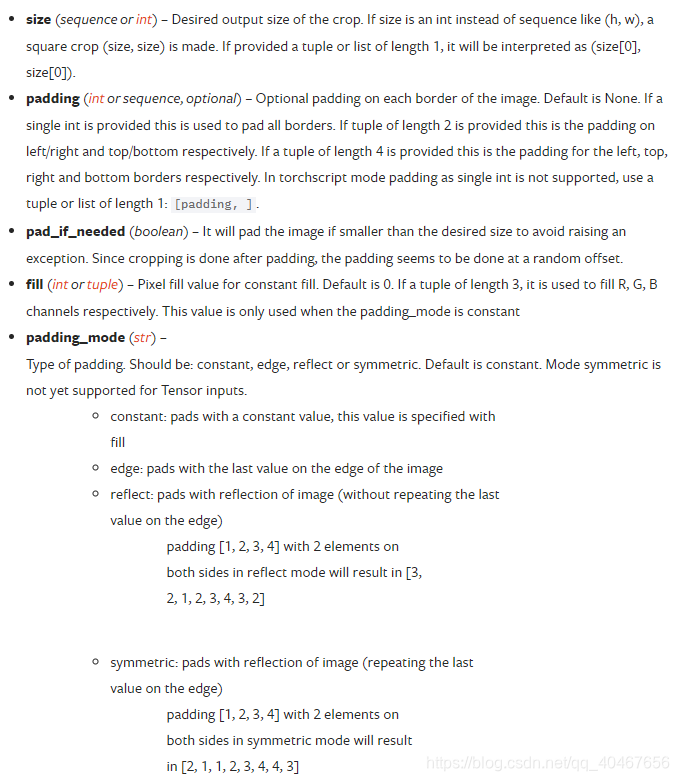PyTorch框架学习五——图像预处理transforms(一)
- 一、transforms运行机制
- 二、transforms的具体方法
- 1.裁剪
- (1)随机裁剪:transforms.RandomCrop()
- (2)中心裁剪:transforms.CenterCrop()
- (3)随机长宽比裁剪:transforms.RandomCrop()
- (4)上下左右中心裁剪:transforms.FiveCrop()
- (5)上下左右中心裁剪后翻转:transforms.TenCrop()
- 2.翻转、旋转
- (1)依概率p水平翻转:transforms.RandomHorizontalFlip()
- (2)依概率p垂直翻转:transforms.RandomVerticalFlip()
- (3)随机旋转:transforms.RandomRotation()
一、transforms运行机制
介绍transforms之前先简单介绍一下torchvision。
torchvision是PyTorch的计算机视觉工具包,包含了一些与CV相关的处理。有三个需要重要介绍:
- torchvision.transforms:包含了常用的图像预处理方法,如数据中心化、标准化、缩放、裁剪等。
- torchvision.datasets:包含了常用数据集的dataset实现,如MNIST、CIFAR-10、ImageNet等。
- torchvision.model:包含了常用的预训练模型,如AlexNet、VGG、ResNet、GoogleNet等。
在transforms中除了具体的预处理方法之外,有一个Compose操作,这里提前介绍,它可以将一系列transforms操作有序地组合包装,以此按顺序执行每一项操作。
torchvision.transforms.Compose(transforms)
参数:

如:
>>> transforms.Compose([
>>> transforms.CenterCrop(10),
>>> transforms.ToTensor(),
>>> ])
二、transforms的具体方法
transforms的操作一般的目的是为了图像预处理和数据增强,所谓数据增强,又称数据增广、数据扩增,它是对训练集进行变换,使训练集更丰富,从而让模型更具泛化能力。下面将介绍二十多种具体的transforms的方法。
1.裁剪
(1)随机裁剪:transforms.RandomCrop()
功能:从图片中随机裁剪出尺寸为size的部分,图像可以是PIL格式或者是张量。
torchvision.transforms.RandomCrop(size, padding=None, pad_if_needed=False, fill=0, padding_mode='constant')
参数如下:

- size:(序列或int)若为int,则是(size,size)的大小,若为序列如(h,w),则大小为(h,w)。
- padding:(序列或int,可选)默认为None,当为整数a时,上下左右的边均要填充a个像素;当为(a, b)时,上下两边填充b个像素,左右两边填充a个;当为(a, b, c, d)时,左、上、右、下分别填充a、b、c、d个像素。
- pad_if_need:(布尔型)如果输入的图像尺寸小于要裁剪的尺寸size,则填充,以防报错。
- fill:padding_mode中constant模式时设置填充的像素值,默认为0。
- padding_mode:填充模式,有四种,constant、edge、reflect和symmetric,默认为constant,而且目前symmetric模式不支持输入为张量(Tensor)。constant模式:像素值由fill设定;edge模式:由图像边缘像素决定;reflect模式:镜像填充,最后一个像素不镜像,如[1, 2, 3, 4]→[3, 2, 1, 2, 3, 4, 3, 2];symmetric模式:镜像填充,最后一个像素也镜像,如[1, 2, 3, 4]→[2, 1, 1, 2, 3, 4, 4, 3]。
下面看一下随机裁剪的几个例子及其效果,变换前图片的原始尺寸为224×224,如下图所示:

(1)随机裁剪尺寸为224,padding=16,即四边都填充16个像素,就是在256×256的范围随机裁剪224×224的大小,效果如下图所示:
transforms.RandomCrop(224, padding=16)

(2)随机裁剪尺寸为224,padding=(16, 64),即左右填充16个像素,上下填充64个像素,就是在256×352 的范围随机裁剪224×224的大小,效果如下图所示:
transforms.RandomCrop(224, padding=(16, 64))

(3)与(1)不同之处就在于像素的填充,这里设定了填充的像素值为(255, 0, 0),效果如下图所示:
transforms.RandomCrop(224, padding=16, fill=(255, 0, 0))

(4)随机裁剪的尺寸为512,大于原始图像的尺寸224,所以pad_if_needed必须设置为True来进行自动填充,扩大尺寸(填充是随机的),效果如下图所示:
transforms.RandomCrop(512, pad_if_needed=True)

(5)与(1)或(3)不同的是,填充模式设定为‘edge’,效果如下图所示:
transforms.RandomCrop(224, padding=64, padding_mode='edge')

(6)与(1)或(3)或(5)不同的是,填充模式设定为 ‘reflect’ ,效果如下图所示:
transforms.RandomCrop(224, padding=64, padding_mode='reflect')

(7)最后看一个综合一点的:
transforms.RandomCrop(1024, padding=1024, padding_mode='symmetric')

(2)中心裁剪:transforms.CenterCrop()
功能:从图像中心裁剪图片,图片可以是PIL格式或是张量。
torchvision.transforms.CenterCrop(size)

例子如下:
transforms.CenterCrop(128)

transforms.CenterCrop(512)

(3)随机长宽比裁剪:transforms.RandomCrop()
功能:随机大小、长宽比裁剪图片,图片可以是PIL格式或是张量。
torchvision.transforms.RandomResizedCrop(size, scale=(0.08, 1.0), ratio=(0.75, 1.3333333333333333), interpolation=2)
参数如下:

- size:同上。
- scale:随机裁剪的大小区间,如scale=(0.08, 1.0),即随机裁剪出的图片面积会在原始面积的0.08倍至1.0倍之间。
- ratio:随机长宽比的范围,默认为(3/4,4/3)。
- interpolation:插值方法,有三种,分别为PIL.Image.NEAREST、PIL.Image.BILINEAR、PIL.Image.BICUBIC,默认为PIL.Image.BILINEAR。
例子如下:裁剪出来的部分是原来部分面积的0.5倍,但是大小又必须为224不变,所以用了默认了插值方法PIL.Image.BILINEAR。
transforms.RandomResizedCrop(size=224, scale=(0.5, 0.5))

(4)上下左右中心裁剪:transforms.FiveCrop()
功能:对给定图像的四个角以及中心进行裁剪,图片可以是PIL格式或是张量,返回一个包含五个元素的元组(tuple),一般都要紧跟一个将元组转变为张量的操作,而且还要注意前后代码尺寸上的匹配。
torchvision.transforms.FiveCrop(size)
参数size同上。
例子如下,紧跟了一个将元组变换为张量的操作:
transforms.FiveCrop(112)
transforms.Lambda(lambda crops: torch.stack([(transforms.ToTensor()(crop)) for crop in crops])),

(5)上下左右中心裁剪后翻转:transforms.TenCrop()
功能:在图像(PIL格式或者是张量)的上下左右四个角以及中心裁剪出尺寸为size的5张图片,TenCrop对这5张图片进行水平或垂直镜像从而获得10张图片。
torchvision.transforms.TenCrop(size, vertical_flip=False)
参数如下:

- size:同上。
- vertical_flip:设置为True时,会垂直翻转,为False时,会水平翻转,默认为False。
transforms.TenCrop(112, vertical_flip=False)
transforms.Lambda(lambda crops: torch.stack([(transforms.ToTensor()(crop)) for crop in crops])),

2.翻转、旋转
(1)依概率p水平翻转:transforms.RandomHorizontalFlip()
功能:依概率水平翻转,输入图像为PIL格式或是张量。
torchvision.transforms.RandomHorizontalFlip(p=0.5)
参数:

例子如下:
transforms.RandomHorizontalFlip(p=1)

(2)依概率p垂直翻转:transforms.RandomVerticalFlip()
功能:依概率垂直翻转,输入图像为PIL格式或是张量。
torchvision.transforms.RandomVerticalFlip(p=0.5)

例子如下:
transforms.RandomVerticalFlip(p=1)

(3)随机旋转:transforms.RandomRotation()
功能:随机旋转图片。
torchvision.transforms.RandomRotation(degrees, resample=False, expand=False, center=None, fill=None)
参数如下:

- degrees:旋转的角度,当为a时,在(-a, a)之间选择旋转角度;当为(a, b)时,在(a, b)之间选择角度。
- resample:(可选)重采样方法(以后细学)。
- expand:(布尔,可选)若为True,则会自动扩大输出尺寸,以保证原图信息不丢失;若为False或省略,输出尺寸保持和输入一致。
- center:(可选)旋转中心,以左上角为原点(0,0),默认旋转中心为图像中心点。
- fill:像素填充值,默认为0,只支持pillow>=5.2.0版本。
注意:expand的计算公式是针对中心点旋转的,若设置为左上角旋转或者其他点为旋转中心,则不能保证保持原图信息。
下面看几个例子:
(1)中心点旋转,范围(-90度,90度):
transforms.RandomRotation(90)

(2)设置expand保持原图信息,图像尺寸自动扩大:
transforms.RandomRotation((90), expand=True)

(3)旋转中心改为左上角:
transforms.RandomRotation(30, center=(0, 0))

(4)旋转中心为左上角并进行expand:
transforms.RandomRotation(30, center=(0, 0), expand=True)
结果不能保证保持原图信息:



)







)


)




)
